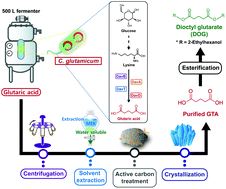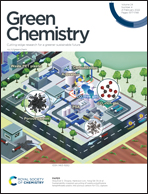Development of a bio-chemical route to C5 plasticizer synthesis using glutaric acid produced by metabolically engineered Corynebacterium glutamicum†
Abstract
Corynebacterium glutamicum was engineered to produce glutaric acid by metabolic engineering approaches starting from the heterologous introduction of the glutaric acid biosynthesis pathway by the expression of Pseudomonas putida davTDBA genes. Two conversion modules i.e., L-lysine conversion module and glutaric acid production module, were constructed on the basis of dual-vector systems to support high-level glutaric acid biosynthesis from glucose with reduced byproducts accumulation. Fed-batch fermentation of the final engineered strain harboring two conversion modules along with Escherichia coli dapBmut (dapBC115G,G116C) expression resulted in the production of 65.6 g L−1 of glutaric acid in a 5 L fermenter. Furthermore, pilot-scale fed-batch fermentation was carried out in a 500 L fermenter to prepare large amounts of glutaric acid, resulting in the production of 56.0 g L−1 of glutaric acid. Glutaric acid produced by the pilot-scale fermentation of C. glutamicum was purified and then used for the synthesis of dioctyl glutarate (DOG) which was further applied in PVC film plasticization and genuine leather coating. It was found that the physical properties of the PVC film plasticized by DOG were comparable to those of the PVC film plasticized by dioctyl succinate (DOS) and dioctyl adipate (DOA). Also, a nitrocellulose (NC) coating agent consisting of DOG could support similar flexibilities and abrasion resistance of leather to those treated with the NC coating agent consisting of DOS and DOA. These results suggest that bio-based DOG developed in this study can be considered as a promising plasticizer having comparable plasticization efficiencies with other aliphatic dicarboxylic acid ester plasticizers.



 Please wait while we load your content...
Please wait while we load your content...